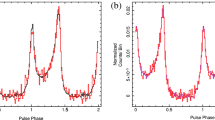Abstract
Pulsar studies in the recent years have shown, more than others, to have benefited from a multi-wavelength approach. The INAF-Astronomical Observatory in Cagliari (INAF-OAC) is a growing facility with a young group devoted to pulsar and fast-transient studies across the electromagnetic spectrum. Taking advantage of this expertise, we have worked to provide a suite of multi-wavelength software and databases for the observations of pulsars and compact Galactic objects at the Sardinia Radio Telescope (SRT). In turn, radio pulsar observations at SRT will be made available, in a processed format, to gamma-ray searches using AGILE and FERMI gamma-ray satellites and, in a near future, they will be complementary to polarimetric X-ray observations with IXPE.

Similar content being viewed by others
References
Bolli P, Orlati A, Stringhetti L et al (2015) Sardinia radio telescope: general description, technical commissioning and first light. JAI 4:50008
Melis A, Concu R, Trois A et al (2018) SArdinia Roach2-based digital architecture for radio astronomy (SARDARA). JAI 7(1):1850004
Pellizzoni A, Pilia M, Possenti A et al (2009) High-resolution timing observations of spin-powered pulsars with the AGILE gamma-ray telescope. ApJ 691:1618
Pellizzoni A, Trois A, Tavani M, Pilia M et al (2010) Detection of gamma-ray emission from the vela pulsar wind nebula with AGILE. Science 327:663
Prandoni I, Murgia M, Tarchi A et al (2017) The Sardinia radio telescope. From a technological project to a radio observatory. A&A 608:40
Ransom SM (2001) New search techniques for binary pulsars. Ph.D. thesis, Harvard University
Saz Parkinson PM, Xu H, Yu PLH, Salvetti D, Marelli M, Falcone AD (2016) Classification and ranking of fermi LAT gamma-ray sources from the 3FGL catalog using machine learning techniques. ApJ 820:8
Weisskopf MC, Ramsey B, O’Dell S et al (2016) The imaging X-ray polarimetry explorer (IXPE). SPIE 9905:17
Acknowledgements
This paper is the peer-reviewed version of a contribution selected among those presented at the Conference on Gamma-Ray Astrophysics with the AGILE Satellite held at Accademia Nazionale dei Lincei and Agenzia Spaziale Italiana, Rome on December 11–13, 2017. The project “Development of a Software Tool for the Study of Pulsars from Radio to Gamma-rays using Multi-mission Data” is supported by the Autonomous Region of Sardinia (RAS), CRP-25476.
Author information
Authors and Affiliations
Corresponding author
Additional information
Publisher's note
Springer Nature remains neutral with regard to jurisdictional claims in published maps and institutional affiliations.
Rights and permissions
About this article
Cite this article
Pilia, M., Trois, A., Bachetti, M. et al. A multi-wavelength pipeline for pulsar searches. Rend. Fis. Acc. Lincei 30 (Suppl 1), 251–253 (2019). https://doi.org/10.1007/s12210-019-00768-x
Received:
Accepted:
Published:
Issue Date:
DOI: https://doi.org/10.1007/s12210-019-00768-x




